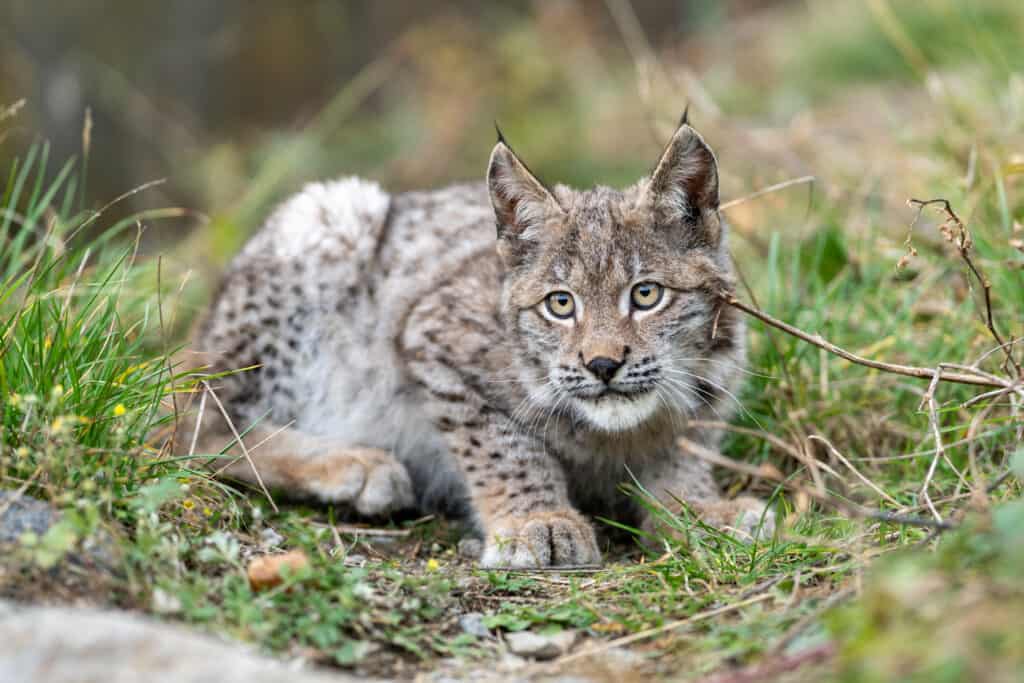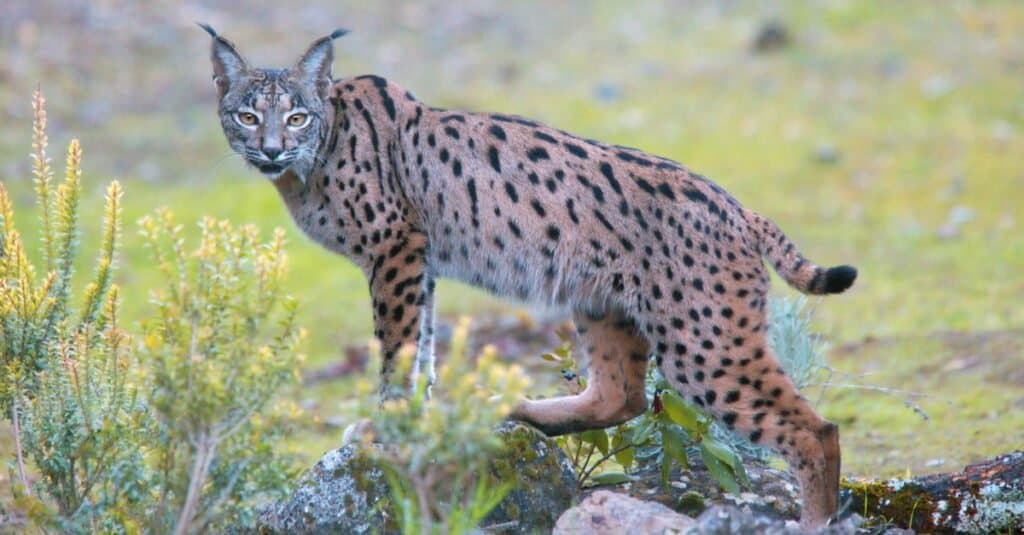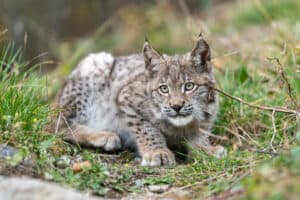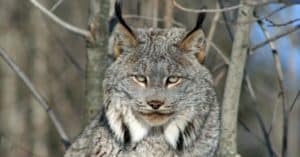The big cats, like tigers, that roam the planet receive a lot of attention from people. After all, they’re very capable hunters, and humans are worried about stumbling across their paths and getting attacked. Anything smaller than a mountain lion may seem less threatening at first glance. That’s not the case, though. Smaller wild cats, like a lynx, can harm a human. You may be wondering, what is a lynx?
Discover what they are, where they’re from, and why it’s a good idea to leave them alone in the wild.
Uncovering the Lynx

Lynx are incredibly agile and fast creatures.
©Felineus/Shutterstock.com
A lynx is any of the four species of the genus Lynx, all of which are medium-sized wild cats that live in North America and Eurasia. These mammals go by different names, with most of them being called lynx and with one North American variant being called a bobcat.
These wild cats vary a fair amount in their size. Generally, they can grow between 28 and 51 inches long and range in height from 19 to 27.5 inches tall. Depending on the species and sex of the creature, they can weigh between 18 and 66 pounds, with the latter weight belonging only to the largest species.
Each of these medium-sized cats is known for its distinct appearance. They have tufts of black hair that stick up from the tops of their ears. Also, they have a ruff beneath their chins, a prong of hair that sticks out on either side of their faces.
They also have short tails and large paws. Their paws are padded and wide, helping them traverse some treacherous environments, like those covered in snow. However, this is just a general overview of mammals. Next, we must consider them on a species-by-species level.
What Are the Four Species of These Cats?

Bobcats have several subspecies.
©Vaclav Sebek/Shutterstock.com
The four species of lynxes are the Eurasian lynx, the Canada lynx, the Iberian Lynx, and the red lynx, more commonly known as a bobcat. Each of the four species has some unique qualities about them. Take a look and learn why it’s not always so simple to answer the question, what is a lynx?
Eurasian Lynx

The Eurasian lynx has pointed, triangular ears that have black tuffs on the end.
©iStock.com/Murmakova
The Eurasian lynx is the largest species of all. They can weigh between 40 and 65 pounds, grow upwards of 4.5 feet long, and stand about 2.2 feet tall. They also have the largest range of any other lynxes. These wild cats can be found in various parts of Europe, Central Asia, and even the Himalayas.
These mammals aren’t endangered, but they are suffering from habitat loss and other problems.
Iberian Lynx

Iberian Lynx, (
Lynx pardinus) among the rocks in Sierra Morena, Andalucia, Spain.
©tony mills/Shutterstock.com
The Iberian lynx is an endangered species of wild cat. They only live in the Iberian Peninsula, the westernmost part of Europe with Spain, Portugal, and a small part of southern France. The Iberian lynx is an endangered species. Their numbers are dwindling for many reasons including severe habitat loss, hunting, and accidental encounters with vehicles.
Members of this species weigh between 20 and 30 pounds, grow about 3.5 feet long, and stand about 2 to 2.2 feet tall.
Canada Lynx

The Canada lynx has thicker fur than cats in warmer climates.
©Through Christy’s Lens/Shutterstock.com
Despite its name, the Canada lynx lives throughout Canada, parts of Alaska, and some of the contiguous United States. This cat can weigh between 18 and 31 pounds, grows about 3 feet long, and stands 1.5 feet to 2 feet tall. They have extra-wide paws that work like snowshoes to help them walk on snow, and they also have thicker fur than any lynxes that live in warm climates.
Bobcat

The red lynx is commonly called a bobcat.
©Laurie E Wilson/Shutterstock.com
The bobcat is also known as a red lynx. On average, bobcats are the smallest of the four lynxes. They weigh between 16 and 30 pounds, grow between 2.4 feet and 3.3 feet long, and stand 1.5 to 2 feet tall.
Still, this mammal is an adept predator. They live throughout North America, with a range that plunges to southern Mexico and reaches as far north as Calgary, Canada.
It should be clear why asking, what is a lynx? can be challenging. They have four different species and numerous subspecies, and they can be mistaken for other animals.
Should I Keep a Wild Cat as a Pet?

A baby lynx may look like a kitten, but it will grow up to be a potent hunter.
©mlorenz/Shutterstock.com
No, you should not keep a lynx as a pet. Some people may look at a lynx and wonder why an animal that size could not be kept as a pet. After all, they’re far smaller than some dogs and look like extra-large, soft domesticated cats.
Make no mistake, these animals are not domesticated, and they lack qualities that would allow them to become domesticated. They’re very temperamental hunters that stalk and kill their prey. They would be far more likely to attack a person or another pet than cuddle.
Have These Cats Ever Killed a Person?
Many reports of these cats attacking human beings exist. Sometimes, the attacks have been caught on video. Fortunately, no verifiable reports of human fatalities from a lynx attack are readily available. That’s because humans are probably too large for wild cats to consider them prey.
That doesn’t mean they are not dangerous to humans. An attack could cause serious injuries to a person, especially children and elderly people. Again, attacks are rare, but it’s still possible that they could harm a human.
What Do Lynxes Eat?

Lynxes eat a variety of foods depending on their species and location. For example, the Canada lynx primarily subsists on snowshoe hares. Like other predatory cats, they stalk their prey before delivering a sudden, fatal attack
They eat many other foods as well, including:
- Rabbits
- Birds
- Carrion
- Deer
- Mice
- Rats
- Small mammals
- Birds
These are just some of the most common foods that lynxes eat. Their diet is diverse across their large range.
Lynxes are interesting mammals. However, they’re also creatures that humans should give a wide berth. They are potentially dangerous animals. Humans cannot domesticate or befriend them. The best way to enjoy their presence is from far away at the zoo or behind a telescopic lens or a phone or computer screen.
The photo featured at the top of this post is © iStock.com/Anita Elder Design
Thank you for reading! Have some feedback for us? Contact the AZ Animals editorial team.






